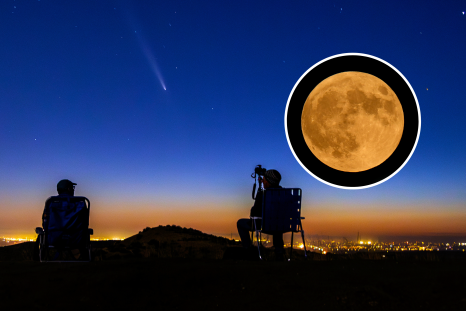As a cloud of the sun's plasma slammed into our atmosphere last week, the northern lights lit up the night sky across the United States, becoming visible as far south as southern California and Mexico.
This "impressive display" of aurorae was sparked by a severe G4 geomagnetic storm from the solar ejection hitting our magnetic field on October 10 and was even spotted from space.
The VIIRS (Visible Infrared Imaging Radiometer Suite) on the NOAA-20 satellite snapped a staggering image of the northern lights rippling across the northern U.S. late on October 10, and astronauts aboard the International Space Station also caught a glimpse of the green and red light show from orbit.
These northern lights were triggered by the G4 geomagnetic storm that resulted from a coronal mass ejection (CME) from the sun hitting our planet's magnetic field.
When the plume of solar plasma and magnetic field interacts with our magnetosphere, magnetic reconnection occurs, distorting our magnetic field.
During a geomagnetic storm, some of these charged particles are funneled into Earth's atmosphere, particularly near the polar regions where magnetic field lines converge. When these high-energy particles collide with oxygen and nitrogen atoms in the Earth's atmosphere, they transfer energy to the atoms, making them glow green and red.
More powerful geomagnetic storms cause the northern lights to be seen further south than usual. Geomagnetic storms are measured on a scale of G1 (minor) to G5 (extreme), with G5 storms being the least common but most powerful. The G5 storm in May this year was the first seen since 2003.
"Although it was a powerful geomagnetic storm, probably the biggest in the last 20 years, it was nowhere near the biggest ever seen. Comparing [May's] storm to the 1859 Carrington Event – the largest storm in the modern scientific record – [May's] event looks more modest. The Carrington Event was probably two to three times as powerful," Jim Wild, a professor of space physics at Lancaster University, told Newsweek.
"We'd expect impacts to be more severe for that level of rare and extreme space weather. But as it's currently constituted, the G1-G5 scale that measures storm intensity tops out at G5, meaning that [May's] activity and the Carrington event would be classed as G5, even though they are quite different."
The Carrington Event of September 1859 was the most powerful geomagnetic storm ever recorded. The storm wreaked havoc on 19th-century technology, particularly telegraph systems, with reports of sparks flying from telegraph machines due to the intense geomagnetic induction in the wires and even fires at some telegraph stations.
More powerful geomagnetic storms can damage our infrastructure, disrupting GPS systems and satellite communications and causing widespread power grid failures.
"The affected infrastructure that is of most importance is large-scale power grids, without which modern society would not be able to function," Brett Carter, an associate professor in space science at RMIT University in Australia, previously told Newsweek.
"Geomagnetically Induced Currents (GICs) are imposed on the power grids, and operators need to contend with them to make sure the equipment does not become overloaded; this is effectively what caused the widespread power outages across Quebec in the infamous 1989 storm. However, research over recent decades has significantly improved the resilience of power grids in key areas."
More powerful geomagnetic storms like last week's G4 and May's G5 could be on the cards in the coming months, as the sun has officially entered its solar maximum, according to NASA.
"Currently, we're about two years into the maximum period, so we're anticipating another year or so of maximum phase before we really enter the declining phase, which will lead us back to solar minimum," Lisa Upton, co-chair of the Solar Cycle Prediction Panel and lead scientist at Southwest Research Institute in San Antonio, Texas, said at a NASA press conference announcing the maximum on October 15.
Do you have a tip on a science story that Newsweek should be covering? Do you have a question about geomagnetic storms? Let us know via science@newsweek.com.
Disclaimer: The copyright of this article belongs to the original author. Reposting this article is solely for the purpose of information dissemination and does not constitute any investment advice. If there is any infringement, please contact us immediately. We will make corrections or deletions as necessary. Thank you.



